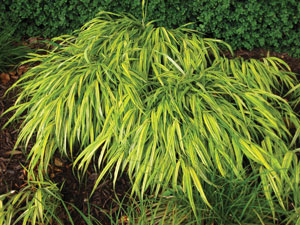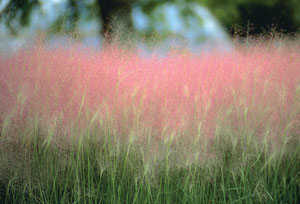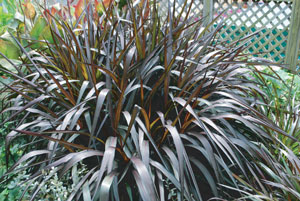2/21/2011
Small Sizes, Big Results
Kerstin P. Ouellet

What comes to mind when you hear or read the words “ornamental grass”?
For many, the phrase conjures up images of huge plants towering overhead: the pampas grass (Cortaderia) that adorns beach houses from Virginia to Florida; majestic sweeps of maiden grass (Miscanthus); or Erianthus, the so-called Northern pampas grass. These giants among grasses can send plumes soaring to 12 ft. or even higher.
Such bold behemoths lend undeniable drama to large plantings, public or private, but they fit the average urban or suburban backyard like a sumo wrestler in the kiddie pool. Fortunately, there are shorter, more compact species and varieties that blend beautifully into even modest-sized gardens.
Grasses in Masses-----
Small garden or large—small grasses or large—one rule holds true. With the exception of monsters like the appropriately named
Miscanthus x giganteus, grasses are most effective in numbers. Large gardens can accommodate grand gestures, like a majestic sweep of Panicum that clearly can’t be shoehorned into more intimate spaces. But gardens of any size can benefit from groupings of smaller genera like Carex, Festuca and Sesleria.
Cheri Markowitz is sales manager and co-owner of Emerald Coast Growers, an ornamental grass propagator based in the Florida panhandle. She’s partial to
Sesleria autumnalis. “It can be massed under trees,” she enthuses, “and it’s semi-evergreen.”
In his book,
The Color Encyclopedia of Ornamental Grasses, landscape consultant and grass expert Rick Darke praises the durable “rich ground color” of a similar species,
Sesleria caerulea, whose blue-green foliage lasts well into winter, and is an effective foil for nearly any color flower or shrub.
Cheri’s colleague Al Mueller, Emerald Coast’s vice president of finance, grows
Carex elata Aurea, a.k.a. Bowles’ golden sedge beside—and in—his backyard pond. It happily adapts to very wet feet in a sunken pot.
Where really compact varieties (under 2 ft.) are called for, Carex is, in fact, the go-to genus. Ice Dance (12 to 18 ft.) brightens any border with green and white variegated arching blades. Ice Ballet is very much like it, only more so, with crisper, cleaner variegation for an even brighter effect. If green and white isn’t bright enough, the creamy gold stripes of Evergold should do the trick.
The ColorGrass series gives growers and retailers an easy, ready-made, useful ornamental selection of mostly Carex varieties, chosen for good pot performance—a key asset. All growers are in the potted plant business, and the better a plant looks in a container, the more likely it is to make it to the register.
Even within genera generally thought of as big grasses, there are versatile exceptions. Miscanthus, for instance, is known for tall, vigorous varieties, but also contains petite forms. Slow-growing Gold Bar stands only 3 to 5 ft. and takes its time getting there. Little Kitten and Stardust are even smaller, at just 1 to 3 ft. each.
Grasses for Shady Gardens-----
A common misconception is that all grasses require full sun. Not so. While many do love a full dose of sunlight, there are plenty of options for shaded settings, too. The most obvious example is Hakonechloa. The best known of the genus is
Hakonechloa macra Aureola. In 2009, this gracefully cascading Japanese import became just the second grass to be named Perennial Plant of the Year by the Perennial Plant Association.
Hakone grass, or Japanese forest grass, forms a waterfall of bamboo-like leaves. Besides Aureola, there are other colorful forms. The leaves of All Gold are, as the name implies, solid gold from stem to tip. For a really unique look, try French-bred Naomi and Nicholas—if you can find them. So far, market demand exceeds supply. Both are just 10 to 14 in. tall. Naomi starts out with creamy white and yellow-green leaves; Nicholas is solid green. Both turn rich purple-red as days become cooler in fall.
Retailers and gardeners alike must bear in mind that all Hakonechloa varieties suffer in full sun in most of America. At retail, it’s best displayed not with other grasses but with shade perennials like Astilbe or Hosta, its natural companions in the landscape.
 Small Native Grasses-----
Muhlenbergia capillaris
Small Native Grasses-----
Muhlenbergia capillaris (3 ft.) is a native gem, with clouds of delicate pink seed heads floating in a sunny haze over fine slender glossy foliage. It needs company to make an impact; one or two plants will just look skimpy. Plant a patch of at least six so they show up.
Another indigenous species gaining traction in design work is
Nassella tenuissima, formerly Stipa. It stands a mere 18 to 24 in., yet commands attention thanks to its soft, threadlike foliage and constant motion in the slightest breeze. It’s terrific and effective in containers or the ground.
Carex pensylvanica is not a showy grass; in nature it’s common, but fairly inconspicuous in the woods of Pennsylvania growing happily in dappled shade. In such natural settings,
C. pensylvanica is found in separate clumps, seldom in thick masses. But that’s the way to use it in the landscape.
Designers at Scott Arboretum and Chanticleer, two public gardens in the suburbs of Philadelphia, use it in swaths on banks and slopes, where it serves quietly as a low-maintenance ground cover that doesn’t compete for attention with decorative plantings nearby.
A similar, finer-leaved form is
C. appalachica. Mary Vaananen, North American Manager of Jelitto Seeds and a garden designer in Louisville, calls it one of “my fave smaller ornamental grasses. Plant it en masse.” She’s also fond of the non-native
Calamagrostis arundinacea var. brachytricha (4 ft.), which thrives in part shade in Kentucky with “fantastic blooms,” and
Carex comans Bronze, “happy and hardy in our area (Zone 7, 12 to 14 in.).”
Grasses That Aren’t-----
Mary and Cheri both rate
Acorus gramineus Aureus Minimus highly. Not a true grass, variegated sweetflag has long been classified in the Araceae, with relatives like Spathiphylum and Aglaonema. Some taxonomists consider it a family unto itself, Acoraceae. By any nomenclature, moisture-loving sweetflag is a tiny treasure. Standing just 3 to 4 in. tall, it’s easily overlooked among large grasses but impossible to miss when properly placed. The fragrant foliage emerges yellow and becomes greener later in the season.
Annual Grasses-----
Finally, don’t overlook the tender stuff. Perennial grasses have become a mainstay in gardens of all sizes, but there’s always room for a specimen container of something as pretty as
Pennisetum x advena Rubrum. Its gorgeous red-burgundy leaves and foxtail plumes rise to 4 to 5 ft. Its offspring, Fireworks (2 to 3 ft.) and Skyrocket (just 20 to 30 in.), take up even less space. The last two are part of the Celebration Series. A third variety, Cherry Sparkler, is planned for release in 2012.
Some very different Pennisetum varieties have been selected at the University of Georgia. Princess Caroline (2 to 3 ft.) and Princess Molly (14 to 20 in.) are the new generation of a series of broad-leaved napier grasses, with highly ornamental dark foliage. They make terrific container or landscape plants, and are highly resistant to the leaf spotting that disfigured their parents, the first introductions in the series.
Another tender option is
Melinis nerviglumis (18 to 24 in.), whose flamboyant pink flowers last from summer well into fall. It won’t survive most winters north of Zone 9, but it’s worth replanting for that long show of color.
GP
Kerstin P. Ouellet is president of Pen & Petal, Inc., a marketing, advertising and public relations firm for the green industry.